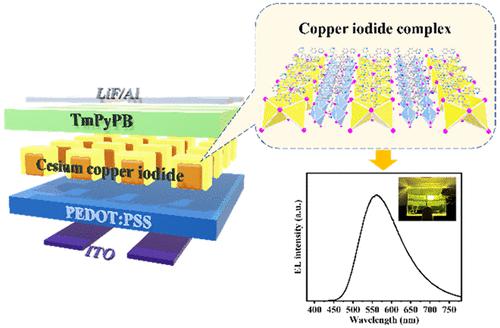当前位置:
X-MOL 学术
›
ACS Energy Lett.
›
论文详情
Our official English website, www.x-mol.net, welcomes your
feedback! (Note: you will need to create a separate account there.)
Low-Voltage Driving Copper Iodide-Based Broadband Electroluminescence
ACS Energy Letters ( IF 19.3 ) Pub Date : 2022-11-14 , DOI: 10.1021/acsenergylett.2c02471 Rui Xu 1 , Dingshuo Zhang 2, 3 , Junjie Si 1 , Yihang Du 1 , Qianqing Hu 1 , Xiaoming Hao 1 , Hong Zhao 1 , Peiqing Cai 1 , Qi Ai 1 , Xin Yao 1 , Yun Gao 2, 3 , Meiyi Zhu 3 , Zenan Zhang 1 , Muzhi Cai 1 , Hin Wai Mo 4 , Kentaro Harada 4, 5 , Zhizhen Ye 2, 3 , Xingliang Dai 2, 3 , Chihaya Adachi 4, 5 , Zugang Liu 1
ACS Energy Letters ( IF 19.3 ) Pub Date : 2022-11-14 , DOI: 10.1021/acsenergylett.2c02471 Rui Xu 1 , Dingshuo Zhang 2, 3 , Junjie Si 1 , Yihang Du 1 , Qianqing Hu 1 , Xiaoming Hao 1 , Hong Zhao 1 , Peiqing Cai 1 , Qi Ai 1 , Xin Yao 1 , Yun Gao 2, 3 , Meiyi Zhu 3 , Zenan Zhang 1 , Muzhi Cai 1 , Hin Wai Mo 4 , Kentaro Harada 4, 5 , Zhizhen Ye 2, 3 , Xingliang Dai 2, 3 , Chihaya Adachi 4, 5 , Zugang Liu 1
Affiliation

|
White light-emitting diodes (WLEDs) based on copper iodides have attracted tremendous interest due to their broad emission and environmentally friendly nature. Cesium copper iodide is usually regarded as the emissive center in this type of LED. Here, we reveal that it is the in situ formed copper iodide complex, generated during the deposition of the electron transporting layer on cesium copper iodide films, that dominates the electroluminescence. It is also found that the narrow bandgap and widely distributed band-edge states of the complex facilitate the hole injection, resulting in low-voltage driving. Combining a modified hole injection layer to suppress the interfacial exciton quenching, an efficient broadband LED with a turn-on voltage of 2.3 V and a peak EQE of 4.6% was achieved. The driving voltages at 100 and 1000 cd m–2 are 2.9 and 4.9 V, respectively, both of which are the lowest among all reported Cu(I) complex-based broadband WLEDs.
中文翻译:

低压驱动基于碘化铜的宽带电致发光
基于碘化铜的白光发光二极管 (WLED) 由于其广泛的发射和环境友好性质而引起了极大的兴趣。碘化铯铜通常被认为是这类 LED 的发射中心。在这里,我们发现它是原位形成的碘化铜络合物,它是在碘化铯铜薄膜上沉积电子传输层期间产生的,它主导了电致发光。研究还发现,配合物的窄带隙和广泛分布的带边态有利于空穴注入,从而实现低电压驱动。结合改进的空穴注入层来抑制界面激子猝灭,实现了具有 2.3 V 开启电压和 4.6% 峰值 EQE 的高效宽带 LED。100 和 1000 cd m 的驱动电压–2分别为 2.9 和 4.9 V,两者都是所有报道的基于 Cu(I) 复合物的宽带 WLED 中最低的。
更新日期:2022-11-14
中文翻译:

低压驱动基于碘化铜的宽带电致发光
基于碘化铜的白光发光二极管 (WLED) 由于其广泛的发射和环境友好性质而引起了极大的兴趣。碘化铯铜通常被认为是这类 LED 的发射中心。在这里,我们发现它是原位形成的碘化铜络合物,它是在碘化铯铜薄膜上沉积电子传输层期间产生的,它主导了电致发光。研究还发现,配合物的窄带隙和广泛分布的带边态有利于空穴注入,从而实现低电压驱动。结合改进的空穴注入层来抑制界面激子猝灭,实现了具有 2.3 V 开启电压和 4.6% 峰值 EQE 的高效宽带 LED。100 和 1000 cd m 的驱动电压–2分别为 2.9 和 4.9 V,两者都是所有报道的基于 Cu(I) 复合物的宽带 WLED 中最低的。











































 京公网安备 11010802027423号
京公网安备 11010802027423号